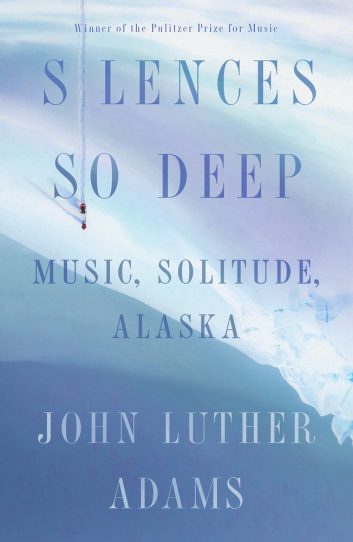John Luther Adams spent much of his adult life in Alaska, not for the mountains or the stargazing but for the quiet. It allowed the composer to think, and, more important, to listen. He carried a music notebook on walks and took dictation directly from the birds. He practiced his tympani parts for the Fairbanks Symphony Orchestra on sofa pillows. In the backcountry cabin where he lived alone for most of the 1980s, he had one clock and resented its every tick. So he kept it in the refrigerator where he could not hear it. “If I really needed to know the time,” he writes in his new memoir, “I had to make a conscious decision to walk into the kitchen area, open the door, and peer in among the fruits and vegetables.”
Silences So Deep chronicles a humble and unusual but musically ambitious life. It is a generous work, full of wisdom about artistic vision and its association to place. Ironically, the most affecting aspect of a memoir ostensibly about a life lived apart is its portrayal of Mr. Adams’s enduring bonds with two dear friends. The fragile thread between connection and remove runs through the book’s pages.
Mr. Adams, now 67, describes his childhood in Georgia and New Jersey, education at CalArts, and eyebrow-raising first marriage to the daughter of notorious rocket engineer Wernher von Braun. The book also notes the avant-garde composers who served as influences, including Edgard Varèse, Morton Feldman and John Cage. After moving to Alaska in the late 1970s, Mr. Adams faced a choice between environmental activism and artistic pursuit. He chose the latter and has since been a prolific if underappreciated composer.
The book’s description of Mr. Adams’s solitary cabin is worth the price of purchase. He took his inspiration from Thoreau’s Walden, and it is hard to imagine another American creating art in a more romantic or challenging setting. The cabin was situated 10 miles from Fairbanks, and lacked running water or plumbing. One week in 1989 the temperature outside did not rise above -55 Fahrenheit. Furnishings included a wood stove, table, chair, couch and piano. The location of the cabin on permafrost prevented much gardening and required Mr. Adams to level the structure with a hydraulic jack each spring. He often saw more moose than people.
In this foreboding landscape he transmuted the sounds of the northern wilderness into evocative pieces like “Forest Without Leaves” (a cantata for choir, vocal soloists and chamber orchestra) and “In the White Silence” (music for string quartet, string orchestra, harp, celesta and vibraphone). His orchestral work “Become Ocean” was awarded the Pulitzer Prize. The music is difficult to describe: lush, dense, serene but containing forms often pegged to mathematical structures. Mr. Adams’s use of rhythm, mixture of acoustic and electronic elements, and portrayal of place can be heard reflected in the compositions and film scores of Jonny Greenwood, Cliff Martinez and Trent Reznor. In a 2008 profile in the New Yorker, the critic Alex Ross wrote that “Adams’s major works have the appearance of being beyond style; they transcend the squabbles of contemporary classical music.”
One of Mr. Adams’s champions was his friend Gordon Wright. The music director of the Fairbanks Symphony and founder of the Arctic Chamber Orchestra, Wright owned a cabin half a mile from Mr. Adams’s. They struck an agreement: Wright’s orchestras would perform Mr. Adams’s works if Mr. Adams would agree to play percussion. A former rock drummer, Mr. Adams accepted, and so maintained a connection to literature from the standard concert repertoire. The two men sustained each other, hooting like owls and sweating in Wright’s sauna. When Wright died in 2007, Mr. Adams helped bring his body down the mountain on a sled.
The other great friendship chronicled in Silences So Deep is between Mr. Adams and the poet John Haines, from whose verse Mr. Adams takes the book’s title. Beyond providing years of steady company and encouragement, Haines, who died in 2011 at age 86, offered a cautionary tale. “A strong artist, he created a world of his own imagining, a world he inhabited, largely alone,” Mr. Adams writes. Living in isolation cut Haines off from friends, led to five unsuccessful marriages, and strained his ability to interact with others. The reader senses that, for both Wright and Haines—who lived “with high ideals and without compromise, far beyond the boundaries of convention”—the cost of independence may have been too high.
Mr. Adams, by contrast, eventually rejoined society. He left his lonely cabin in 1989 and has since enjoyed a 30-year marriage, first in a traditional Fairbanks home, and then in the Lower 48. The departure from Alaska in 2014 was painful. “I love Alaska with a passion that is almost erotic,” Mr. Adams writes. But after his friends died and the effects of climate change accelerated, he and his wife found they no longer wished to stay. “Looking at satellite images of the retreat of the sea ice is like looking at photos of someone I love wasting away from a horrible disease,” he writes. “It is heartbreaking.” They now divide their year between Manhattan and Mexico. He composes music in the desert.
It is a fitting time for a meditation on making art while confined in solitude. Mr. Adams and his peers chose exile; alone among them, he renounced it. Notably, he has been more productive since doing so. Everyone must find the proper balance between togetherness and time spent apart. Yet if we needed a reminder in 2020 that we were not meant to be cut off from one another, it is the sound of a composer hooting into the wild and hoping to hear back from his departed friend.







